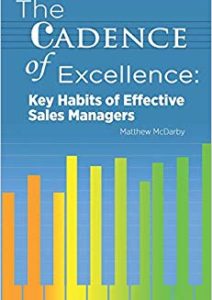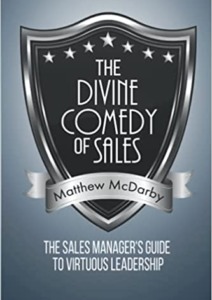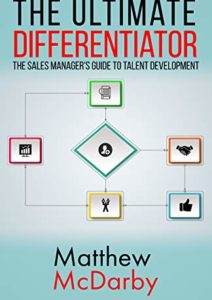Editor’s Note: Today we post Chapter 6 of a 10-chapter book, authored by our CSO, John Golden and Matt McDarby, President of United Sales Resources.
Did you know there is something called “Like farming”? You’ve probably seen the ads that promise hundreds of Facebook Likes or thousands of “real” Twitter followers for a small fee. “Like farmers” began to spring up once the vanity metric of Likes made its way into corporate marketing KPIs. Perhaps you’ve considered buying from one of these charlatans. It’s OK. We understand. Let’s just agree never to speak of it again.
“Shares” are another attractive social metric that has become a big focus for marketers over the last few years. If a content consumer shares a piece of content with others (i.e., social media contacts), the assumption is that they must have found value in that piece of content — so much so that they chose to share with their closest friends, business associates, former colleagues, ex-bosses, and blood enemies. But what if that content consumer is one of those lazy sharers who doesn’t really consider whether something is useful before sharing with the world?
When your brilliant post about an industry issue or opportunity is shared with your target market, it’s a good thing. But the value of that Share depends largely on a few things that are out of your control:
- Is the person sharing the content that I posted really a trusted authority on the topic I’m covering?
- Is the Share being positioned properly? Is it being pushed without consideration to why others would value it, or is it being offered alongside a question or a thought that might help others understand why the content is worth reading?
- Do recipients of your shared content value the opinion and shared content of the sharer?
While Likes and Shares are perhaps very early, leading indicators of deeper engagement that is to come, they can also be misleading as performance metrics.
The point is that Likes and Shares don’t pay the bills. Sales do. Disciplined sales / revenue generation teams establish and maintain an active funnel of engaged prospects at all times to ensure a pipeline that will deliver the desired business outcome.
- Engage (verb): to hire (someone) to perform a particular service: to pay for (help, services, etc.): to get and keep (someone’s attention, interest, etc.): to induce to participate
- Engagement (noun): an arrangement to meet or be present at a specified time and place
- Engaging (adjective): tending to draw favorable attention or interest
To really understand what buyer “engagement” means, one must consider what today’s buying journey looks like.
Back in 1989, in Neil Rackham’s seminal book on the buying process, Major Account Sales Strategy he offered research that buyers go through some predictable and identifiable phases as they move from early problem/opportunity recognition to an eventual buying decision. That is still true today, but the way buyers move through that predictable process has changed in terms of how and when they interact with potential suppliers.
Buyers continue to seek answers to a set of important questions as they progress through their decision-making cycle, but they are asking some new questions during that process as they self-educate and weigh their needs, opportunities, risks, and options. They ask the following questions:
- “Do we have a problem? Do we have an opportunity? Are those problems or opportunities important enough to deserve an investment of our valuable time?”
- “How clear are we about the problem or the opportunity? Do we really understand the cost of leaving the problem unsolved? Do we know the payoffs associated with capturing this opportunity?”
- “What are some ways that others have addressed these issues or opportunities? If they succeeded, how did they do it? If they failed, why did they fail?”
- “Who can help us? Who has the ability to help us think through our issues and opportunities? Can we trust them? Can we gain some insights from them, preferably for free?”
- “If it is worth our while to consider potential solution providers/suppliers, how will we judge them? Does anyone else (like us) have experience working with suppliers (like them)?”
- “Who will we invite into discussion to clarify our needs…?”
It has traditionally been the job of the seller to attempt to create value in the buyer’s eyes and differentiate from competitors by identifying with, aligning with, and influencing the buyer’s decision-making process. Notice, however, that none of the questions that typically come up during the earlier parts of the buyer’s journey require a salesperson to answer them. They are all “self-service” questions now, and therefore, direct engagement with buyers early in the buying process is proving to be more elusive to sellers than ever before — so a great deal of focus and thinking now is on the topic of social selling.
“You Like Me. You Really Like Me!”
Will a buyer engage with information about you or your company based on a Facebook Like or Share or Twitter Follow or Retweet by someone they know? Sometimes. Will they find you or members of your team at all when they research their issues, opportunities, or potential solutions and suppliers via social media? Sometimes.
So the challenge is to generate real social engagement with a prospective buyer and not simply to get them to Like us or Share our stuff. Real social engagement looks a lot like it always has. We just happen to be writing about social engagement enabled by technology.
Remember the definitions. Engagement, means, “An arrangement to meet or be present at a specified time and place.” The verb, engage, means, “To hire (someone) to perform a particular service; to pay for (help, services, etc.); to get and keep (someone’s attention, interest, etc.); to induce to participate.”
The definitions are essentially the same, whether we apply them to online, in person, in a phone call, or in other, virtual environments.
A person generally agrees to take a step like that with someone else because they see value and low risk in interacting. Social media is just another platform in which that step forward can be taken.
The aim of social selling is to convert technology-enabled interactions between people into real-world buying activities. In the end, if social media interaction does not turn into buyer action — think Specific-Measurable-Achievable-Relevant-Time based action (S.M.A.R.T) — then it will not lead to a sale.
A sales manager can be instrumental in helping their team convert social engagement into buyer action and commitment.
The Social Engagement Pipeline
So, we’ve established that clarifying problems, identifying opportunities, understanding risks and payoffs, and narrowing the list of potential sources of help are still very much a part of the buying journey. Just because we revenue generators aren’t as much a part of those stages of the buying journey as we once were doesn’t mean that they’ve stopped. They’re just happening without us, which means that we need to keep close track on what our buyers are doing. Shouldn’t we try to find some way to identify, think critically about, and plan our approach and achieve real engagement with our prospective customers as they address their issues and opportunities?
If your answer is, “Heck, yes,” then consider the idea of a Social Engagement Pipeline. This social engagement pipeline is a way for a sales manager and salesperson (or a team of them) to focus on the early engagement with prospective buyers.
The table below is a simple example of a social engagement pipeline for an individual salesperson.
| Date | Social Likes | Social Shares | Direct Social Interactions | New Social Connections | Agreements to Meet / Engage |
| 1/1 to 1/7 | 3 | 4 | 1 | 1 | 1 |
| 1/8 to 1/14 | 5 | 1 | 0 | 2 | 1 |
| 1/15 to 1/21 | 0 | 1 | 2 | 0 | 1 |
| 1/22 to 1/28 | 15 | 8 | 2 | 3 | 4 |
FIG 6.1 Social Engagement Pipeline, Summary Version
Other pipelines could include more detail, such as the names of prospects that comprise the four social shares during the week of January 1st, from the above example. In any case, like any other tracking tool, the value comes from not only the act of tracking social engagement but also to help salespeople and managers understand how the social pipeline reflects the salesperson’s productivity.
The dialogue between coach and rep might sound something like this:
Coach: “Tell me about Jane Doe. You indicated that you connected with her on LinkedIn a few weeks ago. Did she reach out to connect with you or vice versa?
Rep: “I reached out to her to connect after she and I traded comments in a group we’re both a part of on LinkedIn.”
Coach: “Yes, I see that you mentioned in your social engagement summary that you had a nice exchange with her about X.”
Rep: “Yeah, we were both commenting on an issue in the market. She spoke about it from a user’s perspective, and I offered some general reflections that I’ve heard from others in a similar situation.”
Coach: “That’s great. Have you asked her if she’d see any value in possibly reading our article about that topic? We’ve had some positive feedback from a lot of people about that piece because it identifies an opportunity for everyone in our market.”
Rep: “Yes. She responded to say she’d like to see the article, so I sent it to her directly through LinkedIn.”
Coach: “Great. Has she committed to read the article?”
Rep: “Now that you mention it, she has not committed to reading it, so I’d better go back to her in a few days to confirm receipt and ask for some feedback. Does that sound right to you?”
Coach: “Yes. Sounds like a smart approach to me. Assuming she is able to find time to read the article and it resonates with her on some level, what are you going to propose as a next step?”
RevGen: “I think I’ll propose that we either chat by phone or meet online to dig a little bit deeper into her issues and to see if and how we can actually help.”
Coach: “Great plan.”
Consider the payoff of analyzing which social contacts represent your team’s best, most receptive, real-world prospects. Would your reps be able to focus some more effort on cultivating discussions with those people over time? Might they possibly be able to leverage some of the common ground or common contacts they have with a prospective buyer as a basis to build some trust?
If the overall answer to those questions is, “Yes,” then let’s think about how the social engagement pipeline can be applied to your business. We recommend applying the K.I.S.S. principle to the social engagement pipeline. Use a simple ratio of Actions to Outcomes. In other words, how many Actions or interactions (e.g. a discussion with a prospect over social media) does it take for a salesperson to achieve a desired Outcome (e.g. commitment for a live discussion with a prospect via phone or web conference). If your team is paying attention to how many times they convert social interactions into real-world commitments from prospects, then they can gauge more or less the effectiveness of their social media engagement.
Figure 6.2: Social Engagement Pipeline View, Measuring Social Selling Actions to Successful Outcomes In Buying Process
A sales manager armed with these metrics can, in a very straightforward and fact-based way, help an individual or sales team to assess when they’ve succeeded, when they’ve struggled, and begin to consider the value of their activities. Therein lies a wonderful opportunity for the sales manager to create some insight for his or her team and to enable the team to take steps to improve the effectiveness of their social selling effort.
Key Points From This Chapter
- Applying metrics to social selling is a good concept, but there are some false metrics, at least as pertains to converting social media interaction into sales in the real world.
- The buying process, though fundamentally the same as it’s been for a long time, has changed in ways that affect salespeople and their activities.
- Though buying behavior has changed, there is still an opportunity for sales teams to positively contribute to the new buying journey to understand, clarify, and address issues and opportunities.
- Sales managers play the pivotal role in helping sales teams focus their social selling activities and measure their real-world impact.
Read the rest of this series:
- Typing Too Much Is the New Talking Too Much: Chapter 5
- Using Social Channels to Align With Your Buyer’s Journey: Chapter 4
- Social Profiles as a Branding Opportunity: Chapter 3
- Sales Managers as Agents of Change: Chapter 2
- Managing a Social Selling Team: Chapter 1














